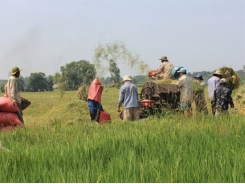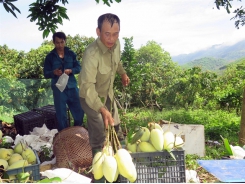New Zealand supporting development of fruit industry

Workshop hears of country's efforts to bolster Vietnam's fruit industry.
Participants examine Dragon fruits at "National Workshop on Development Model and Commercialization of High-quality Fruit Varieties" (Photo source: Thanh Nien Newspaper)
In order to improve the value chain of high-quality fruit varieties and promote the development of Vietnam’s fruit industry, the “National Workshop on Development Models and the Commercialization of High-quality Fruit Varieties” was held by the Embassy of New Zealand in Vietnam and the Ministry of Agriculture and Rural Development (MARD) on June 5 in Ho Chi Minh City.
Addressing the workshop, New Zealand Ambassador H.E. Wendy Matthews spoke of the lessons from the “Develop High-quality Fruit Varieties” project that has been implemented for six years in Vietnam’s south. The project has cost $5.6 million, funded by the New Zealand Development Aid Program.
It helped promote innovation in farming methods that contributed to doubling fruit output and saw the introduction of post-harvest washing and fruit cooling techniques to reduce fruit damage and prolong storage.
Comprehensive and innovative studies of the project reduced the impact of brown spot disease and helped farmers use less chemicals. The project also helped farmers grow dragon fruit to increase their return on investment. At the same time, it also developed a number of new high-quality dragon fruit plants with higher export potential.
The project was implemented by the New Zealand Plant & Fruit Research Institute (PFR) and Vietnamese partners including the Southern Fruit Research Institute (SOFRI) and Sub-Institute of Agricultural Engineering and Post-Harvest Technology (SIAEP).
According to Ambassador Matthews, the “Develop High-quality Fruit Varieties” project successfully combined New Zealand’s world-class expertise in agriculture with one of Vietnam’s most special fruits - dragon fruit.
“I’m very proud that the project has brought significant benefits to Vietnamese farmers and their families,” she said. “By sharing successful models from New Zealand in the field of fruit cultivation, we hope to support Vietnam to rapidly develop its high-quality fruit industry.”
According to Mr. Tran Kim Long, Director of the International Cooperation Department at MARD, dragon fruit is classified into 12 important fruit trees in Vietnam and is one of nine major crops of the country that have a competitive advantage in world markets. Dragon fruit is planted in cities and provinces nationwide but primarily concentrated in the provinces of Binh Thuan, Long An, and Tien Giang in Vietnam’s south, with an area of about 53,000 ha, of which Binh Thuan has the largest area, of more than 27,000 ha.
Recent figures from the General Statistics Office show that the country’s fruit and vegetables are exported to 40 countries and territories, including fastidious markets such as the US, South Korea, Japan, and the Netherlands, with total fruit and vegetable production worth $3.8 billion in 2018.
Accordingly, MARD has set a target that by 2020 the export turnover of Vietnam’s fruit industry alone will reach $3.6 billion. Many major programs and solutions need to be carried out in order to reach the goal, including reorganizing production and developing markets, especially large markets.
New Zealand has greatly supported Vietnam in fields such as agriculture, education and skills development, and disaster risk management, outlaying $17.6 million from 2015 to 2018.
Có thể bạn quan tâm
Phần mềm

Phối trộn thức ăn chăn nuôi

Pha dung dịch thủy canh

Định mức cho tôm ăn

Phối trộn phân bón NPK

Xác định tỷ lệ tôm sống

Chuyển đổi đơn vị phân bón

Xác định công suất sục khí

Chuyển đổi đơn vị tôm

Tính diện tích nhà kính

Tính thể tích ao hồ




 Rice exports drop in first months of this…
Rice exports drop in first months of this…  Over 100 ha of fruit trees in Tan…
Over 100 ha of fruit trees in Tan…